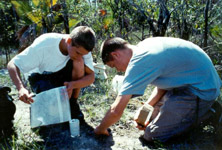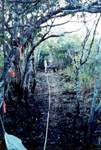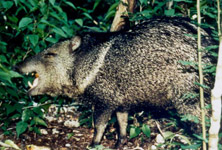HabitatNet: A Global Biodiverrsity Monitoring
Project
Field Report Number 6:
El Eden Ecological Reserve Quintana Roo, Mexico
August, 1999
Submitted By: Dan Bisaccio, HabitatNet Project Director
Abstract:
Further biological diversity monitoring activities for
the 1999 field season included two HabitatNet field courses. The two
field programs were lead by the HabitatNet Project Director (January,
July) in which Quadrats 12, 17 (January) and Quadrats 22, 23 (July)
were completed. The January field course participants were from Souhegan
High School (Amherst, NH) and the July field course participants included
teachers and college students (Souhegan High School graduates) from
across the United States and Canada.
As of this report, fourteeen (14) of the twenty-five
(25) quadrats are completed within the hectare biodiversity plot (known
as EEF1). Three additional quadrats (quadrats 13,19,25) are nearing
completion.
Reference Note:
Past HabitatNet Field Reports (Numbers 1,2,3,4,5) describe
the habitat types, protocols used in this biodiversity monitoring
project, quadrat data, and species accounts. Copies of all reports
are on file at the El Eden Ecological Reserve (Quintana Roo,MX), the
Smithsonian Institute/ Man & Biosphere Program (Washington, D.C.),
and with the Project Director at Souhegan High School (Amherst, NH).
 Trip
Reports: (January, 1999 published as Trip Report # 5)
Trip
Reports: (January, 1999 published as Trip Report # 5)
10 July - 18 July, 1999 HabitatNet Biodiversity Assessment
Institute
We returned to a very green El Eden Ecological Reserve
in July with secondary school teachers and college students to continue
work at Biodiversity Plot EEF1. The rainy season had begun in earnest.
During the week, Quadrats 22 and 23 were mapped and surveyed. Additionally,
maximum / minimum temperature and humidity data were taken at Quadrat
1 and species accounts noted.
Trip Data:
January 1999
(1) Temperature & Humidity
|
Temperature
|
|
|
Maximum
|
28o C
|
|
|
Minimum
|
25o C
|
|
(2) Canopy Density
Quadrat 12: 90%
Quadrat 17: 90% (evidence of wind thrown trees and early
successional trees)
Trip Data:
July 1999
(1) Temperature & Humidity
|
Temperature
|
|
| Maximum |
31o C |
93% |
| Minimum |
29o C |
77%
|
(2) Canopy Density
Quadrat 22: 80%
Quadrat 23: 70%
(3) Species Accounts
A. Birds: 33 species were observed (field notes/ checklist
D.Bisaccio).
B. A "moth" species was observed and photographed
by D. Bisaccio on a night hike that mimiced a dragonfly. Photographs
were submitted to: E.O.Wilson & P. DeVries (Harvard University)
and A. Gomez-Pompa (University of California/ Riverside) for identification.
It may be a new species.
Concluding Remarks
"If the land mechanism as a whole is good, then
every part of it is good, whether we understand it or not. If the
biota, in the course of eons, has built something we like but do not
understand, then who but a fool would discard seemingly useless parts?
To keep every cog and wheel is the first precaution of intelligent
tinkering."
Aldo Leopold: A SAND COUNTY ALMANAC
Certainly, this report is just a beginning. Much more
work needs to be done and will be done over the next several years.
Basic taxonomic work complimented with continuing investigations of
species interactions will allow us to more fully understand and appreciate
the wisdom of Aldo Leopold.
Organismic adaptation and speciation can not keep pace
with the accelerating extinction rate caused by our species ignorance.
In addition to the basic research and investigations afforded by this
project, a primary focus of HabitatNet is to reacquaint students and
teachers with nature so that we may better understand our fundamental
role and responsibility in safeguarding global biological diversity.
 The
short term goals for 1999 - 2000 include:
The
short term goals for 1999 - 2000 include:
(1) Continue quadrat tree surveys in the hectare biodiversity
plot known as EEF1.
(2) Develop a botanical reference collection at El Eden
(voucher specimens).
(3) Under the auspices of Marco Lazcano-Barrero, develop
a voucher specimen collection of both invertebrate and vertebrates
found within the biodiversity plot.
(4) Fall 1999/ Winter 2000: Begin intial interpretation
of quadrat data compiled thus far.
Resources Used in Compiling This Report
Bisaccio, Dan. "Field Report: El Eden Ecological
Reserve: Numbers 1,2,3,4,5"
El Eden Website: University of California http://www.ucr.edu/pril/peten/images/el_eden/Home.html
Emmons. Neotropical Rainforest Mammals. University of
Chicago Press: Chicago, IL
Gentry. A Field Guide To The Families and Genera of
Woody Plants of Northwest South America. Conservation International:
Washington, D.C.
Lazcano-Barrero. Marco. Identification of snake species
from discarded skin; April,1998
Lee, Julian. The Amphibians and Reptiles of The Yucatan
Peninsula, Cornell Uiversity Press, 1996
Smithsonian Institute's MAB Digest # 11 , Technical
Report on conducting biodiversity monitoring research. Francisco Dallmeier,
editor.
Smithsonian Institute: MABDATA BioMon Software: DOS
program for managing data compiled at biodiveristy sites; Smithsonian
Institute (SI/MAB), 1992
Will, Tom. "Checklist To Birds of The Yucatan,
Mexico", Gettysburg University, PA1997
Appendix I (Attached)
1. Cumulative Data for all quadrats surveyed thus far:
Quadrats 1,2,3,4,6,7,8,9,11,16,19,21, 12, 17, 22, 23
2. Quadrat Maps and Surveys completed in 1999. (Q. 12,17,22,23)
Appendix II - El Eden Ecological Reserve / HabitatNet
Participants 1999
Researcher Credits:
January 1999:
|
Susie Carlisle
|
Jessica Charpentier
|
Amy Verrault
|
|
Margaret Lambert
|
Emily Ginsberg
|
Scott Mohler
|
|
Christine Deysher
|
Ben Day
|
James Fasoli
|
|
Courtney Gould
|
Eric Boericke
|
Sarah Kayser
|
|
Lisa Ferrari
|
Brett Mayes
|
|
|
Bonnie Miller
|
Erik White
|
|
July 1999:
|
Leonora Isaak
|
Emily Ginsberg
|
Ben Day
|
|
Dawn Schultz
|
Sarah Kayser
|
Janet Drew
|
|
Bruce Larson
|
Brett Mayes
|
Margaret Lambert
|
|
Kathleen Bird
|
Courtney Gould
|
|
|
Jessica Charpentier
|
Erik White
|
|